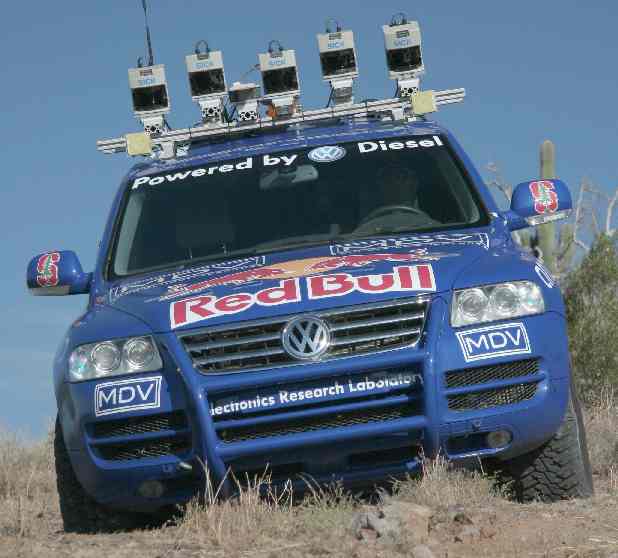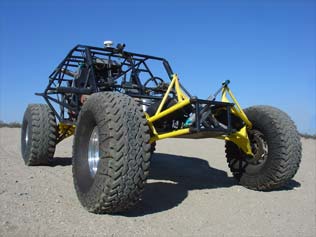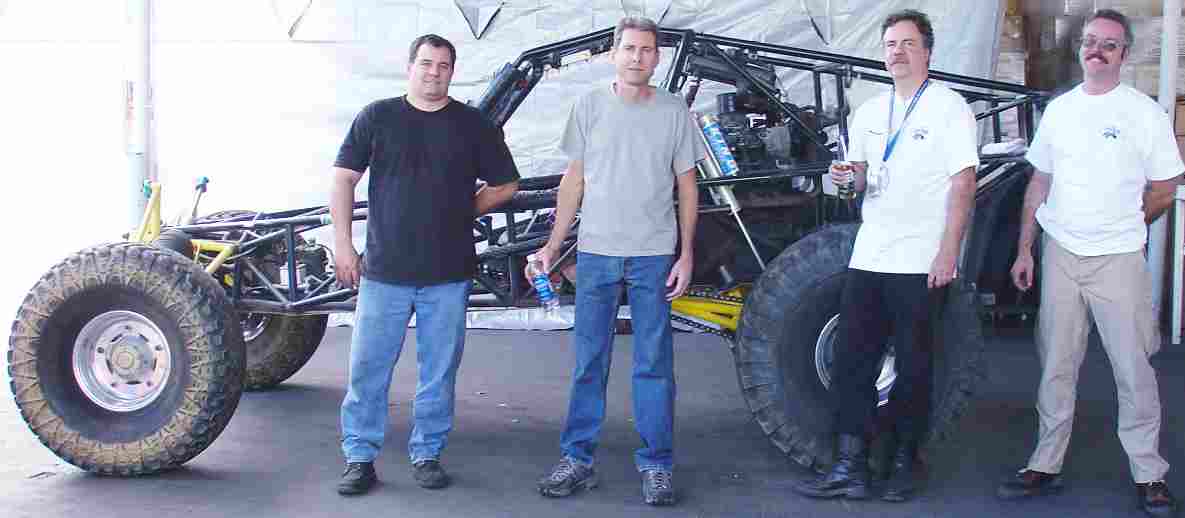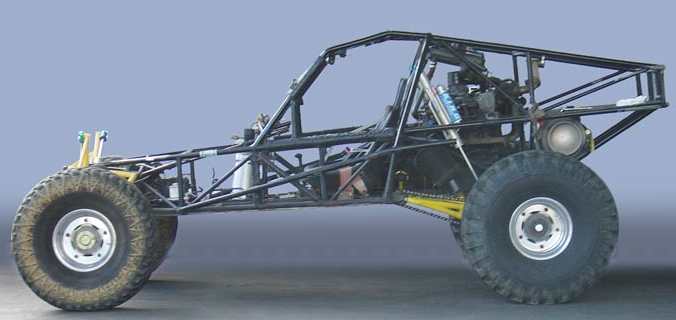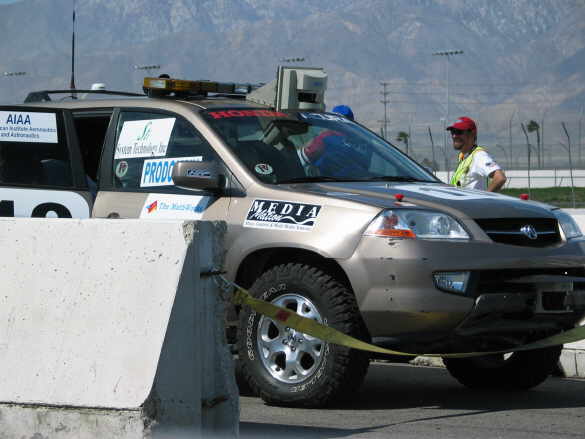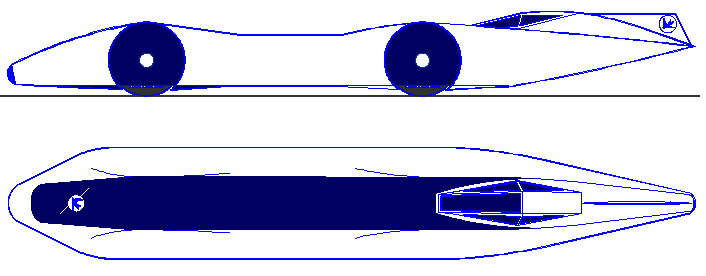|
DARPA GRAND CHALLENGE 2005
|
||||||
|
HOME | AUTOMOTIVE | BLUEPLANET | ELECTRIC CARS | FORMULA E | ENERGY | INSURANCE | INDEX | SOLAR CARS |
||||||
|
WHAT IS DARPA ?
THE DARPA GRAND CHALLENGE
Home
I Mission
and Overview I DARPA
Offices I Doing
Business with DARPA
$2 million Prize awarded to Stanford Racing Team
Stanford University - 2005 DARPA winner
After the embarrassment of last year's DARPA Grand Challenge, both the U.S. Defense Department and teams of engineers came back even more determined to see the contest end successfully. On Saturday, October 8, that's exactly what happened.
A heavily-modified 2005 Volkswagon Touareg named "Stanley" and representing Stanford University Racing finished the 131.6 mile trek with no human input to steer the vehicle through the Nevada desert, earning the Stanford team a cash prize of $2 million in taxpayer dollars and a whole lot of bragging rights.
Right behind Stanford was a pair of bright red vehicles, both a lot duller from their dust coats, representing Red Team from Carnegie Mellon University. The first CM car, a modified 1986 Hummer named "Sandstorm," came in 11 minutes later, followed by another Hummer, dubbed "H1lander."
Thirty minutes later came the only other team to finish that day, a 2005 Ford Hybrid Escape named "GrayBot" from The Gray Insurance Company. Gray sponsored the team, which consisted of Tulane University students, from Louisiana. Perhaps theirs is the greatest success story of the contest, as they had two hurricanes to contend with along with the desert winds.
The Stanford Vehicle (nicknamed "Stanley") is based on a stock, Diesel-powered Volkswagen Touareg R5, modified with full body skid plates and a reinforced front bumper. Stanley is actuated via a drive-by-wire system developed by Volkswagen of America's Electronic Research Lab.
All processing takes place on seven Pentium M computers, powered by a battery-backed, electronically-controlled power system. The vehicle incorporates measurements from GPS, a 6DOF inertial measurement unit, and wheel speed for pose estimation.
While the vehicle is in motion, the environment is perceived through four laser range finders, a radar system, a stereo camera pair, and a monocular vision system. All sensors acquire environment data at rates between 10 and 100 Hertz. Map and pose information are incorporated at 10 Hz, enabling Stanley to avoid collisions with obstacles in real-time while advancing along the 2005 DARPA Grand Challenge route.
The development of Stanley began in July 2004. At the time of the initial team application, the vehicle is largely functional and has logged dozens of autonomous miles along the 2004 DARPA Grand Challenge course.
The Stanford Vehicle (nicknamed "Stanley") is based on a stock, Diesel-powered Volkswagen Touareg R5, modified with full body skid plates and a reinforced front bumper. Stanley is actuated via a drive-by-wire system developed by Volkswagen of America's Electronic Research Lab.
Technical Papers Team technical papers have been posted. Technical Papers.
Pictures from DARPA Grand Challenge 2005 Photos from the Grand
Challenge Event and the National Qualification Events are available for
download. Event
Photos
Cyber Rider - DARPA contestant
The Buzz...
“…Now
we need to teach them how to drive in traffic.”
The DARPA Grand Challenge is a competition and field test over rugged desert terrain, to accelerate research and development in autonomous robotic ground vehicles. Optech’s ILRIS-3D Intelligent Laser Ranging and Imaging System is being incorporated as a key component in the sensor array of Team Mojavaton’s 2005 entry, a Nissan Xterra (dubbed the “Xboxx”) autonomous vehicle. No remote control is permitted. Once the vehicles leave the starting line, they must rely exclusively on their on-board sensors , navigation instruments, and computers to “see” the terrain ahead and follow the course to the finish line 150 miles away.
“This
capability of true three-dimensional imaging and the associated artificial
intelligence which must be employed to interpret the data will undoubtedly
provide a strategic advantage over previous imaging strategies,” said
Brent Gelhar, Director, Laser Imaging Division for Optech. “This will
not merely be a reactive collision avoidance system, it is an active
spatial recognition tool.”
“We are very fortunate to have Optech as a partner in this event,” said Jim Crittenden, Team Mojavaton’s team leader. “Their experience and the quality of their equipment is unsurpassed and both will be a tremendous advantage in this exciting project. They are clearly at the leading edge of this technology.”
At
the first DARPA Grand Challenge, held in March 2004, 15 vehicles operating
autonomously attempted a 142-mile route through the Mojave Desert. Since
no vehicle was able to complete the route, DARPA is hosting this second
Grand Challenge event. None of these vehicles completed the course, so the
$1,000,000 went unclaimed. The second Grand Challenge will take place on
Saturday, October 9, 2005. The location has only been announced as
“somewhere in the California/Nevada desert area.” The prize for the
fastest vehicle to complete the course in less than 10 hours will be
$2,000,000 this time.
Cyber Rider - DARPA team members
Press Releases
Cyber Rider - DARPA contestant
Team CyberRider is comprised entirely of volunteers. Based in Orange County, the team is a non-profit organization. They are not funded at taxpayers expense. Team CyberRider is using their non-profit status as an outreach to the Southern California educational community, by challenging local High School and College students to participate in this landmark event.
Rules for DARPA Grand Challenge 2005 were published on October 8, 2004. E-mail questions about the rules to Grandchallenge@darpa.mil. Rules
Video Demonstration Guidelines (January 28, 2005) Site Visit Instructions (February 15, 2005) Preliminary E-stop Guidance (March 7, 2005) Site Visit Instructions Update (April 8, 2005) Site Visit Frequently Asked Questions (April 21, 2005) Technical Paper Guidelines (July 19, 2005) Area Closure (July 29, 2005) RDDF Document (August 3, 2005) Sample RDDF (August 3, 2005) NQE Handout (August 8, 2005) GCE Handout (August 22, 2005) NQE Course (August 23, 2005) NQE Practice Area Route (August 29, 2005) Sample Inspection Checklist (August 29, 2005) Rules Clarifications (September 8, 2005) Garage Assignment (September 8, 2005) Grand Challenge RDDF (October 20, 2005)
For a compilation of replies to questions sent to the Grand Challenge staff, click here.
Palos Verdes High School doom buggy
Fifteen Teams Qualified to Compete in 2004
After a week of qualification, inspection and demonstration (QID) at the California Motor Speedway, 15 teams qualified to participate in the DARPA challenge. All teams demonstrated that they could traverse the practice courses safely while avoiding obstacles. The vehicles are all totally autonomous (they have no driver). They will be departing from Barstow, California starting at 6:30 AM on March 13th, 2004. The teams hope to have their robotic vehicles arrive across the desert in Primm, Nevada in under ten hours.
Director of DARPA, Dr. Anthony Tether commented: "When we first came up with the idea of the Grand Challenge, our hope was to attract the most talented and diverse group of teams. The final group of teams shows that our effort to attract top-quality participants has been an unqualified success."
Each competing vehicle will be trailed by a vehicle containing government officials and an emergency stop system to prevent collisions or other unsafe situations. There are boundaries that the vehicles must stay within or be disqualified. Disabled vehicles will be removed from the course.
The selected teams are listed below in official starting order, based on results from the QID:
1. (22)
Red
Team - Pittsburgh, PA
OTHER AUTONOMOUS PROJECTS
2. University of Washington - Seaglider 3. Slocum sea glider - Doug Webb & Henry Stommel 4. MIT Cambridge University - Controlling Drone with Mobile Phone 5. Scout Transatlantic - autonomous robot Atlantic crossing project 6. Roboboats - Autonomous Surface Boats competition, ASVs 7. Robosubs - Autonomous Underwater Vessel competition AUVs 8. USNA - Roboboat competition team 2011 & 2012 9. Sea Robotics - Unmanned systems 10. Woods Hole Oceanographic Institution - ABE lost at sea 11. University Western Australia - USAL robot sub 12. Microtransat - Competition for autonomous sailing models 13. CMTI - Centre for Maritime Technology and Innovation - Autonomous Study 14. MUNIN - Maritime Unmanned Navigation through Intelligence in Networks & E-Nav International 7th Framework 15. MONALISA - Motorways of the Sea, eco-efficient e-navigation solutions contribution to safe maritime transport 16. INDAGATUS - Small endurance UMV platform
Please click on the links above to find out about these famous automotive makers. If your company is not included and you would like to be listed, please let us know.
It's not what you see that counts, it's what they are working on in secret. If you don't keep up, you're losing.
A taste for adventure capitalists
The world's fastest electric car: 350mph + using energy from nature. Featuring built in battery cartridge exchange, charged using renewable solar energy. Sponsors sought for the 2016 season.
|
||||||
|
BLUEPLANET BE3 ELECTRIC | EDUCATION | ELECTRIC CYCLES | SOLARNAVIGATOR |
||||||
|
The
content of this website is copyright © 1991 and 2013 Electrick
Publications. All rights reserved. The bluebird logo |
||||||
